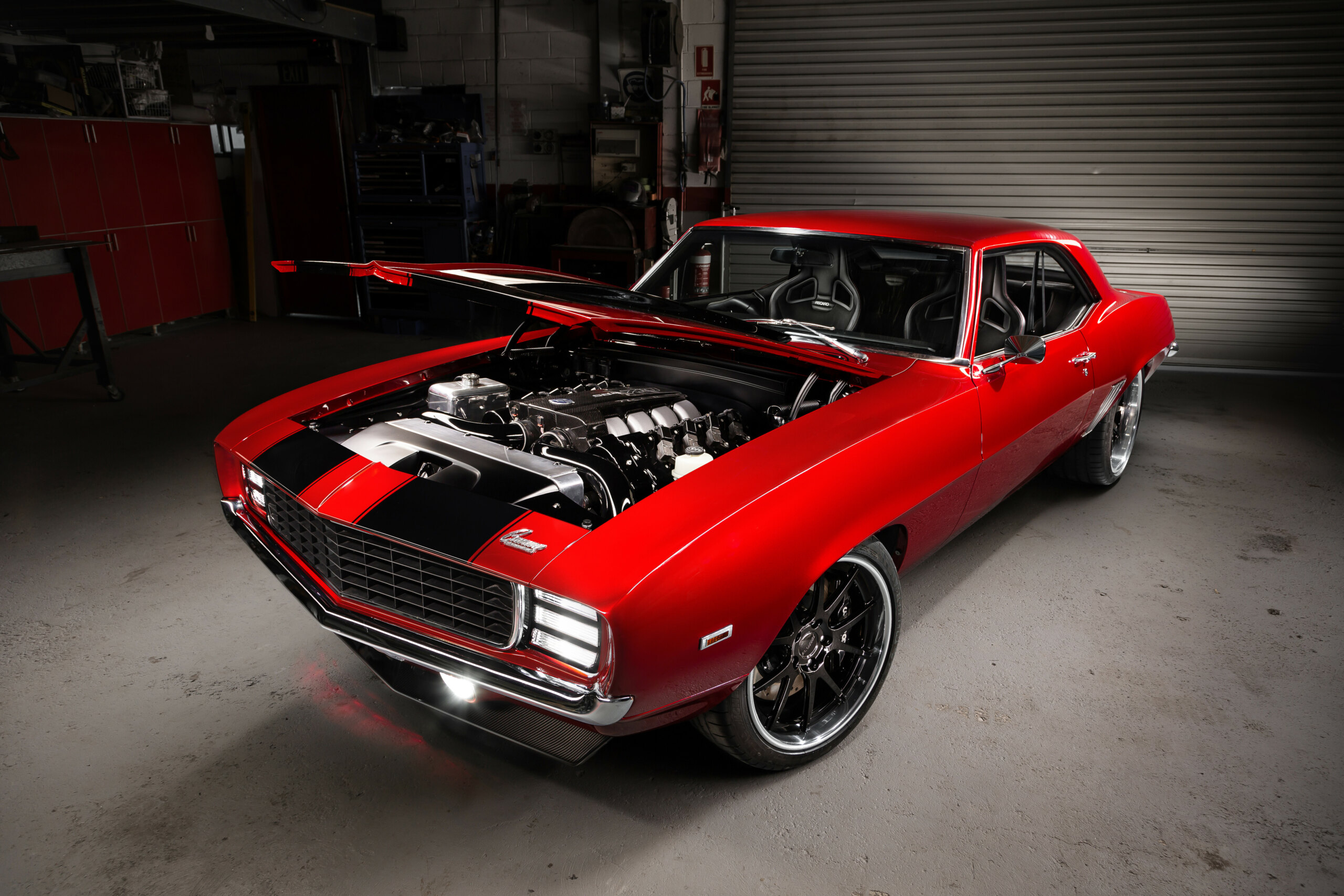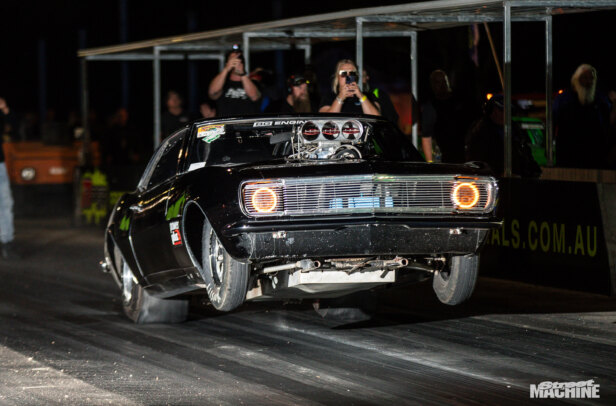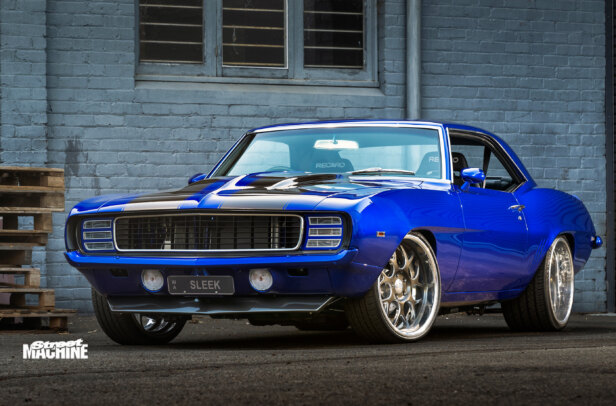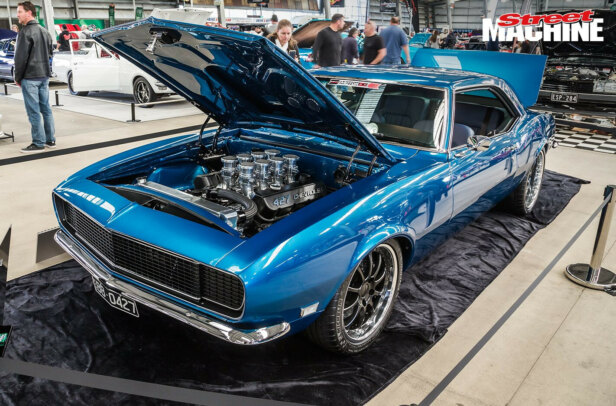THE epic, American-style pro touring ’69 Camaro you see here began its journey from tired RS to corner-carving masterpiece thanks to the intervention of owner David’s long-suffering family.
First published in the April 2021 issue of Street Machine
“I have always liked Camaros, and had been looking at them online for ages,” David begins. “My son Zac was around eight at the time and went off his brain at me saying I’ll never get one of these cars. My wife Frances was also quite tired of me talking about Camaros and searching for them every night. She ended up looking at my browsing history on Carsales, and organised my workshop mechanic to go look at this car.” Dave’s family then bought the Camaro for his 40th birthday!
With his dream car finally in his possession, Dave had firm plans for its future. “I always wanted to build a pro tourer,” he says. “I used to read a Camaro-specific magazine and followed pro touring legends like Mark Stielow and Mary Pozzi. It’s fun to see show cars prepped to the nth degree, but I wanted a high-end street car, a car to be used.”
Having already gifted him the ’Maro, Dave’s wife Frances, son Zac and daughter Bianca backed that up in 2018 by surprising him with an epic, quad-cam,7.0-litre Mercury Racing SB4 V8 for Christmas! Due to factory F-body pony cars having the rigidity of wet spaghetti, Dave also hit up Art Morrison in the USA for chassis connectors, an independent rear end and an upgraded front clip, plus huge 14-inch Wilwood brakes and Forgeline GA3C wheels.
Now Dave had all the hardware that America’s top pro tourers run, but finding a shop to turn the parts into a righteous ride proved tough at first. “I had the car at a shop for six months, but it hadn’t even been touched after that time, so I finally got hold of them and went and collected it,” he sighs. “Image Conversions is only five minutes away from where I work, so Matt and Mick came and had a look. Matt, Mick and Paul were very, very good to work with. They hooked in and got the job done so quickly; it’s only been a year-and-a-half since it went to their shop!”
Image Conversions is a family business that started out building stretch limos, but these days Matt and Mick Ellard have been growing the company’s reputation for constructing beautifully finished cars that can have the wheels driven off them – like Daniel Wickman’s Barra XM Falcon from the cover of our December 2020 issue. And the exotic powerplant that Dave had ready for the Camaro got the Ellard brothers enthused.
“We were keen to get started on David’s Camaro because the Mercury Racing engine excited us,” says Mick Ellard. “We read into the specs and thought this car would be an animal; plus being the first car in Australia with the SB4 engine was pretty cool.”
Mick says that planning and having a clear vision of the end goal made the build process much easier. “David did his research; he had a plan for the car and nothing has changed through the whole build,” he says. “This makes building custom cars a lot easier, as it gave the car direction. The build was about 18 months from start to finish; the only thing that slowed the process down was shipping from the US.”
Matt was in charge of removing the original frame rails and fitting the Art Morrison upgrades, along with sorting rust repairs, fixing the panel gaps and handling the interior build. Mick then massaged the body and coated it in the rich 2019 Camaro Garnet Red. It was then on to the assembly shop, where Paul Buys got the tungsten-tough driveline fitted up.
This included the SB4 (read more below), which uses a 7.0-litre LS7 bottom end and Mercury Racing’s own DOHC cylinder heads for a thumping 750hp at 7500rpm, along with a twin-plate McLeod clutch in the Tremec gearbox and the Art Morrison Dana 60 IRS set-up down the back.
“I wanted to build it as a bit of a tribute to a COPO Camaro, so that’s why I wanted a 427ci V8,” says Dave. “I looked into engineering and was told we couldn’t get a blown 7.0-litre passed, so I turned to looking at aspirated engines. You get everything from Mercury with the SB4, including the front drive, ECU, the whole thing, so it made the price comparable to other [off-the-shelf] built engine options. We haven’t even had to get it tuned, because it was ready to go out of the box.
“I got to drive it from Riverstone to Botany for emissions testing, which was awesome, even though I’m only pulling it to 5000rpm – not 8000rpm – at the moment. But it’s berserk,” Dave laughs. “Once it’s broken in, it will be a hell of a car to drive. I’d like to do some track days, but I am toying with the idea of entering it into the Optima Challenge later in the year.”
With 750hp in a Torana-sized car and all the handling of a late-model Corvette, this pony car will be one to watch when it does hit the track!
THIRSTY MERC
DEBUTING at SEMA in 2016, the naturally aspirated Mercury Racing SB4 7.0 (which stands for ‘small-block, four valves per cylinder, 7.0L’) is a less complex, less extreme variant of the company’s 1650hp, twin-turbo, 552ci QC4 boat donk. The DOHC heads were modelled off the QC4 castings but have been designed to fit LS-family bottom ends, with twin timing belts with hydraulic tensioners instead of three chains to improve maintenance requirements.
While pushrod V8s make ridiculous horsepower, Mercury Racing chose to develop DOHC cylinder heads for its boat and auto engines due to enhanced intake and exhaust port flow. This means extra horsepower, higher rpm limits, improved valvetrain durability from lower mass and stress, and the ability to run milder cams due to gains in flow, which improves street manners and the spread of power available.
One real benefit to running cams in the cylinder head is less load on the valvetrain, safeguarding those parts in a high-stress environment. Across four valves per cylinder, the lighter springs, valves and buckets mean there is less load shared among them compared to a two-valve pushrod set-up, where the valve spring has to manage a heavier valve, rocker, pushrod and roller lifter – especially at high revs. The seat pressures of the valve springs are reduced by going to overhead cams, improving wear on valve seats.
The short motor is based off the iconic LS7 that Mercury Racing reworks into a spicy li’l burrito. The SB4 uses a 4.125in bore and 4.0in stroke with 11.7:1 compression, producing 750hp at 7500rpm. Up top, Mercury Racing’s own twin-throttle intake and electronic 80mm throttles are used, along with shaft-mounted rockers with mechanical lash adjustment, coil-on-plug ignition and sequential-port fuel injection. A fourth-gen Camaro LS1 sump takes 6.6L of 10W-30 synthetic oil underneath.
The SB4 weighs 226kg without accessories or serpentine system.
DAVID
1969 CHEVROLET CAMARO RS
Paint: 2019 Camaro Garnet Red
ENGINE
Brand: Mercury Racing SB4 7.0L
Induction: Mercury Racing twin-throttle intake, two 80mm throttlebodies
ECU: Mercury Racing
Heads: Mercury Racing DOHC by Edelbrock
Camshafts: Mercury Racing
Conrods: Manley forged H-beam
Pistons: Mahle Motorsport forged 11.7:1
Crank: Callies DragonSlayer
Oil system: Holley sump (modified)
Fuel system: Cadillac CTS-V fuel pump, Rick’s Tanks EFI tank
Cooling: PWR radiator
Exhaust: Liverpool Exhaust 2in to 21/8in to 21/4in stepped headers, 3.5in collector, X-pipe, twin system
Ignition: Coil-on-plug
TRANSMISSION
Gearbox: Tremec T56 Magnum six-speed
Clutch: McLeod RST twin-plate
Diff: Strange Engineering Dana 60 centre, Truetrac, 3.73:1 gears
SUSPENSION & BRAKES
Front: JRi aluminium double-adjustable coil-overs, 550lb springs, Flaming River rack-and-pinion steering, Art Morrison front clip, C6 Corvette control arms
Rear: JRi aluminium double-adjustable coil-overs, 450lb springs, Art Morrison independent rear end, Detroit Speed mini-tubs, Detroit Speed subframe connectors
Brakes: Wilwood 14.25in discs (f & r); Wilwood Aero6 calipers (f), Wilwood Aero4 calipers (r)
Master cylinder: Wilwood
WHEELS & TYRES
Rims: Forgeline GA3C; 19×10 (f), 20×12 (r)
Rubber: Michelin Pilot Super Sport; 275/35R19 (f), 305/30R20 (r)
THANKS
Matt, Mick and Paul at Image Conversions; Bill at Hy-Tone Upholstery; Mobility Engineering; Australian Transmission Components; B&R Brakes Blacktown; Ricks Tanks; Burns Stainless for header design; Liverpool Exhaust; Art Morrison; The Roadster Shop; Mercury Racing; Harrop; Anything Automotive for the right-hand-drive dash




Comments